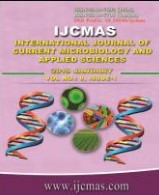


 National Academy of Agricultural Sciences (NAAS)
National Academy of Agricultural Sciences (NAAS)

|
PRINT ISSN : 2319-7692
Online ISSN : 2319-7706 Issues : 12 per year Publisher : Excellent Publishers Email : editorijcmas@gmail.com / submit@ijcmas.com Editor-in-chief: Dr.M.Prakash Index Copernicus ICV 2018: 95.39 NAAS RATING 2020: 5.38 |
The study was carried out to investigate bovine tuberculosis and diagnostic potential of IFN-γ assay and necropsy inspection in different abattoirs of Assam and Meghalaya, including its species identification. A total number of 234 animals were screened by IFN-γ and necropsy inspection. IFN-γ was performed according to kit procedures and carcasses were inspected for any gross visible lesion. Species identification was confirmed by biochemical test (viz. Nitrate reduction test, Pyrazinamidase test and Niacin detection test) and PCR targeting pncA and oxyR gene. The inter-rater agreement (weighted kappa) among different screening tests was analysed using standard software. Gross visual lesions were found in 48 (20.51%) carcasses whereas 43 (18.38%) animals were reactive to IFN-γ. Suspected 119 tissue samples were collected from 48 animals. Pre-culture stain revealed 83 (69.75%) and culture growths were from 96 (80.67%) tissue samples. Highest lesions were recorded in lymph nodes (56.30%) followed by lungs (16.80%) and liver (8.40%). Pre-scapular (38.80%) and retropharyngeal (26.86%) contribute more lesions than other lymph nodes. The sensitivity and specificity of IFN-γ was 81.58 % and 98.29% respectively. Very good Inter-rater agreements (kappa) were observed between IFN-γ, culture and pre-culture stains and good agreement between IFN-γ and necropsy inspection. Our results indicate visual inspection may serve as good screening method for tuberculosis infected carcasses although IFN-γ assay before slaughter may give brief idea about the infection. The study confirms the endemic status of bovine tuberculosis in these areas of north east India.
 |
 |
 |
 |
 |